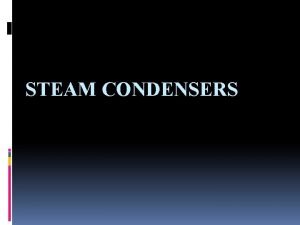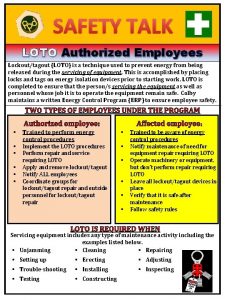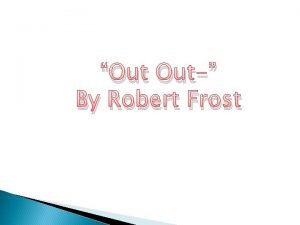The Coming Out Process What is the coming




















- Slides: 20

The Coming Out Process

What is the coming out process? n The coming out process is the time when an adolescent establish his or her identity that is not of the heterosexual norm. n So who are we talking about?

“It starts with an H Henry, and it isn’t Hemophiliac” – Roy Cohn Gays n Lesbians n Bisexuals n Transgender n Intersex n Queer n

What age? Studies pinpoint the coming out age to be around 12 -13 years of age. With first attraction to same sex being somewhere around the same time. n However, many studies find the first attraction to the same sex can be much earlier around the age of 10 and as early as 8. n

What’s the difference between then and now? At one time it was easier to avoid themes of homosexuality. n In the modern age, it is nearly impossible. n Movies, television, and the internet have changed all of this. n

The population has to deal with it in everyday life, as a teacher you will too. n n n Shows such as Will and Grace, Queer as Folk, The “L” Word, and The Real World have given visibility to homosexuality. The visibility of homosexuals in the media may aide an adolescent in finding out who they are. “Given the recent cultural shift around sexuality, it is not surprising that studies are finding that the age at which queer people are coming out is getting younger” (Boxer, Cook, & Herdt)

Influences n Before I speak about what the process of coming out is like for the adolescent, there is some major problems that we have to face first. n Most notably – homophobia

What is homophobia? Unreasoning fear, contempt, or antipathy for homosexuals. n Homosexuals continue to be pathologized and devalued in significant ways. n This poses a risk at how the adolescent (who is concerned with self image) views himself or herself. n

n n n Because homosexuals are met with strong opposition from those in powerful positions, an adolescent may feel as if they are wrong or bad. Meet that with school problems and there is a reason homophobia and the coming out process go together. A study of female youth reported, 85% verbal abuse, 38% had been threatened with physical violence, 24% had something thrown at them, 17% had been assaulted physically and 4% had been assaulted with a weapon (D’Augelli 2005)

n A study of male youth found the case to be worse. 94% had been verbally abused, 57% had reported being threatened with physical violence, 46% report having something thrown at them, 26% had been assaulted physically and 8% had been assaulted with a weapon. (D’Augelli 2005).

So what is it like for the individual student as he or she comes out? n n n The beginning of the coming out process is when the individual begins to develop feelings for the same sex. This is a time of self discovery (This is generally associated with adolescents hitting puberty). This time of self discovery is also associated with denial.

n n n “The pressure to pass as ‘normal’ can create feelings of isolation and fear of discovery” (Harrison 2003). Generally there is a point of regression. At this point the adolescent goes into a denial or becomes very vigilant in retards to behavior, clothing, and body image. The student will then be angry at the self. Blaming others or themselves for the homosexuality. A general anger at society will also occur.

n n n n The adolescent will then bargain with God and other adolescents. The adolescent will ask God for him to convert. The adolescent will continue closeting or renounce homosexuality. Tell friends, but generally afraid to tell family because he or she wants to remain part of the family. A depression will occur before the acceptance. This will be gilled with guilt or shame. The adolescent feels ostracized from society. Mourns the loss of not having children

n n n n The age of coming out to friends (non family/siblings) is about 13. At this point the student will enter an acceptance stage. This may or may not propel them into finding him or herself. A sibling will eventually will be told and at around 16 -18 parents will be told. This obviously depends on each adolescent as there are some factors to remember such as safety, legalities, rejection, violence, etc. With the acceptance of the adolescent’s homosexuality the adolescent will become sensitive to homosexual issues. Other adolescents and the family will learn to cope and integrate homosexuality into family identity.

So who does the adolescent tell? n n Generally it goes: friend, sibling, mother and lastly father. 50% of mothers are able to accept their child’s homosexuality. 60% of siblings were accepting. The minorities face different statistics. African American’s and Hispanics receive much less acceptance. Somewhere in the neighborhood of 30% of mothers were accepting. (Journal of School Health, 2003).

Research indicates parents need time to reach acceptance or tolerance of their child’s disclosed homosexuality. However, few studies specifically addressed paternal process. n What is important to remember is that development of sexual identity is a natural process that may begin at an early age. (Harrison 2003) n

So what can I do as a teacher? n n Studies may lose their friends, family in this process. As an educator there are several things you can do. Safety first – If there is harassment, threats and/or violence contact an administrator who can help with these issues. There is also the GLSEN (Gay, Lesbian, and Straight Education Network) GLSEN. org

n n Make sure that school policies regarding name-calling and other forms of harassment are explicitly inclusive of students of all culture, race, religion, sexual orientation, and gender identities. Actively intervene when name-calling or harassment of any kind occurs. Resist the urge of saying, “Don’t say that” or “That’s Mean. ” Young adolescents are at a crucial time in their cognitive and moral development (especially in middle school) and educators must help them to understand the importance and value of differences.

n n Make sure the student has a safe person whom they can go to if they are having a problem. Be aware of any GSA (Gay Straight Alliance) the school or the community may have. Examine the school curriculum in order to find ways in which to appropriately incorporate gay and lesbian history, literature and role models just as we have attempted to do with African Americans, Hispanics, people with disabilities, and women. Most importantly treat them fair and equal. Homosexual students don’t want to feel special, they want to feel normal and as such treat them that way.

References n n n Bailey, Norma. (2003). Safety for Gay and Lesbian Students in Our Schools. Education Digest. Bernal, Anibal. (2006) Learning from Sexual Minorities: Adolescents and the Coming Out Process. Drake University. Bettinger, Thomas. (2006). Difficulty Dilemmas: The Meaning and Dynamics of Being Out in the Classroom. Inter. Science. Harrison, Therese. (2003). Adolescent Homosexuality and Concerns Regarding Disclosure. Journal of School Health. Retrieved from Education Full Text (WILSON) Payne, Elizabeth. (2006). Heterosexism, Perfection, and Popularity: Young Lesbians’ Experiences of the High School Social Scene. Syracuse University.
 Shot me out of the sky you're my kryptonite
Shot me out of the sky you're my kryptonite Letter writing to parents
Letter writing to parents Condensate extraction pump working principle
Condensate extraction pump working principle Mark knapp relationship model
Mark knapp relationship model Put out the light and put out the light
Put out the light and put out the light The buzz saw snarled and rattled in the yard
The buzz saw snarled and rattled in the yard Out of sight out of mind quote
Out of sight out of mind quote Out out robert frost
Out out robert frost Loto safety talk
Loto safety talk Out out frost
Out out frost Out of sight out of time
Out of sight out of time Matthew 11 msg
Matthew 11 msg Loto
Loto Out, damned spot! out, i say!
Out, damned spot! out, i say! Harmony not discord
Harmony not discord Makna out of sight out of mind
Makna out of sight out of mind Bgsu quality systems
Bgsu quality systems Hát kết hợp bộ gõ cơ thể
Hát kết hợp bộ gõ cơ thể Lp html
Lp html Bổ thể
Bổ thể Tỉ lệ cơ thể trẻ em
Tỉ lệ cơ thể trẻ em






































